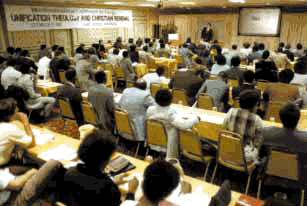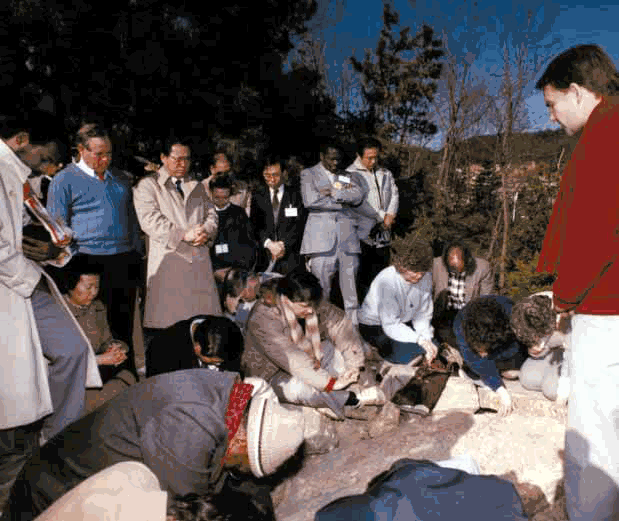
40 Years in America

|
|
40 Years in America |
|
International Conferences for Clergy

ICC conference at Lake Geneva, Wisconsin, September 1984
Despite the spectacular breakthroughs of the Moscow rally and its aftermath, a more internal course ran almost precisely parallel to these events. This more internal course connected Rev. Moonís victory in America, particularly the unity he had attained with Christianity through the Danbury providence, to the movementís spiritual homeland in Korea. Thus, a march to Korea paralleled the march to Moscow. Proclamations made in the movementís homeland and mobilizations of vast numbers of people likewise paralleled the Moscow rally and its aftermath. In addition, Rev. Moonís meeting with North Korean Premier Kim Il Sung paralleled his meeting with Gorbachev. The difference was these rallies and victories, including Rev. and Mrs. Moonís proclamation of their messianic status, were understood to have an eternal and universal validity. Unlike worldly attainments, they were not subject to reversal or recall.
The movementís march on Korea began even prior to Rev. Moonís release from Danbury Federal Prison. While there he "first asked American members to focus on educating 70,000 ministers, and on that foundation to send 7,000 ministers to...Japan and Korea." This request led to the creation of the CAUSA Ministerial Alliance, the 300,000-videotape project, and other activities previously covered. The focus shifted after April 1985 when the movement sponsored its first Interdenominational Conference for Clergy (ICC) in Korea and Japan. Under the theme, "Rev. Moon and Korea in the Providence of God," sixty-four ministers from twenty-one denominations attended an "advanced seminar on Unificationism" between April 10-19, 1985. Between 1985-88, the movement sponsored thirty-eight separate ICC seminars for 7,069 American clergy and religious leaders who traveled to Korea and usually Japan. According to Rev. Chung Hwan Kwak, who had overall responsibility for the project, the "meaning of the 7,000" was connected to the time of Elijah when throughout Israel God prepared 7,000 people who had never bowed down to Baal (I Kings 19:18). Rev. Kwak stated that John the Baptist inherited the position of Elijah and "was to find 7,000 righteous believers among the whole of Israel to work with Jesus." Since Korean Christianity rejected Rev. Moon between 1945-48, the mandate was to bring 7,000 American ministers to Korea between 1985-88, after completion of the forty-year wilderness course. This would be one among numerous conditions of unity set by the movement to restore what was lost during the immediate post-World War II era.
The ICC seminars, which were a decisive first step in the movementís march to Korea, paralleled CAUSA and ALC efforts in its concurrent march to Moscow. However, the ICC ran along an internal track and had pronounced differences from the movementís VOC work. The most obvious difference was the theological content. The CAUSA and ALC meetings attempted to universalize the movementís theological content as "Godism" which emphasized points of convergence for all theistic believers. The theological material presented in the ICC seminars was highly particular, basically straight Divine Principle content.
A second major difference of the seminars was the spiritual dimension. CAUSA and ALC had a significant fellowship component, but they basically conformed to accepted norms of professional meetings. Spontaneous testimonies as to the inner workings of the spirit in oneís heart clearly would have been out-of-bounds, especially in public sessions. The ICC meetings were much different. Not only were the participants welcome to bear witness to all manner of revelations, dreams, visions and other similar phenomena but the conferences were structured in such a way as to encourage and even cultivate this. A third difference was that CAUSA and ALC conferences preached to the already converted. Although some new constituencies were introduced, they were primarily gatherings of the like-minded who were opposed to Marxism and favored traditional values. The situation was quite different in ICC seminars where ministers had met the movement through religious liberty or CAUSA meetings but "had not studied the Principle deeply." As ICC leaders, particularly in the earlier sessions, acknowledged, "Most of the participants do come to Korea with some lingering skepticism or even suspicion about [Rev. Moon]." These factors combined with pre-existing denominational rivalries among participating ministers to generate more heated debates and spiritual battles than in either the CAUSA or ALC meetings.
Itís important not to overstate the extent of these disagreements. In fact, it was precisely because of the initial distance that the ICC sessions were so powerful. Some ministers openly repented for their former misunderstandings or their denominationís persecution of the movement. Others repented for their mistreatment of one another. According to one report, "Many became inwardly hopeful and jubilant that now indeed was the time of the Second Coming.
Others, while they may have rejected the possibility...expressed tolerance and acceptance of our position." Beyond that, ICC leaders hoped that clergy could testify that "God is actually behind...[Rev. Moon] and our movement." To facilitate this, the ten-day ICC seminars introduced participants to the full range of the movementís tradition in its countries of origin, "not what they have heard through the American media." After the first several conferences, the ICC seminar began at Tokyo Church Headquarters where "hundreds of young members lined the sidewalks to greet ministers, exuberantly waving flags and shouting, "Welcome! Welcome!" Each group also attended a Youth Rally where over 1,000 members who had newly joined through "video centers" greeted the ministers "with wild enthusiasm." The unmistakable message was that while Japan was highly resistant, even allergic to traditional forms of Christian witness, the Unification movement was bringing impressive results.

ICC participants pray at the Rock of Tears, Pusan
In Korea, although participants toured industrial facilities, the ICC placed more emphasis upon the movementís humble and suffering origins. Church elders shared experiences from the early days, and ministers toured the old Chung Pa Dong Headquarters Church, including the bare upstairs rooms where Rev. Moon and his family had lived. A day trip to Pusan at Koreaís southernmost tip was usually a highlight. There, they visited a museum that stood on the site of the first Unification Church building -- a hut of mud and cardboard that Rev. Moon constructed when he arrived in the city as a refugee during the Korean War. Many of the guest ministersí most vivid experiences occurred when they climbed the path up the mountain above the site to the "Rock of Tears" overlooking Pusan and its harbor where Rev. Moon "had prayed earnestly for the salvation of the world." Some started crying and praying deeply. In the course of the conferences, many from spirit-filled backgrounds testified to visions and revelations. A conference convener, convinced that the voice he heard at the Rock of Tears was the same voice he had heard at the Wailing Wall in Israel and "that it was the voice of God and that this place was authentic," burst into tears and embraced an ICC lecturer. However, some ministers never made it up the steep, winding climb to the rock, and not all who made it experienced meaningful breakthroughs.
There was always a full cycle of Principle lectures and question and answer panels which usually focused on Rev. Moonís identity, joint Sunday worship at the Seoul Headquarters Church, a banquet at the Little Angels School, and gifts of ginseng tea. From the fourth conference, Rev. Moon requested that participants issue a proclamation of support for the movement "to encourage understanding among all Christians, especially in Korea." The proclamations, with some variation, affirmed that "the Unification Church is a God-centered movement which practices Christian love," that "The Reverend Sun Myung Moon is a man deeply inspired by God and Jesus Christ," that the Unification Principle has exerted a "transforming power in the lives of its followers," and that "the Unification Church has suffered unjustly in many respects because of misunderstanding." Typically, three-fourths or more of the participants signed these. Rev. Moon also suggested that the American ministers establish sister church relationships with Korean Christian churches. This also became a regular part of the conference although a lesser percentage of ministers took part.
Download entire page and pages related to it in ZIP format
Table of Contents
Information
Tparents Home